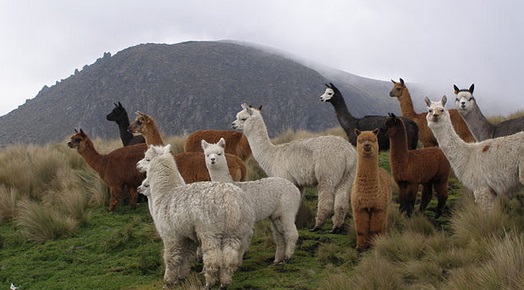Taxonomy
Kingdom |
Phylum |
Class |
Order |
Family |
Genus |
Species |
| Animalia | Chordata | Mammalia | Artiodactyla | Camelidae | Vicugna | Vicugna pacos |

Alpacas grazing in their natural habitat in the Andes
0
Name:
- Scientific Name: Vicugna pacos
- Common Name: Alpaca
Habitat and Distribution
- The alpaca is a camelid indigenous to the Andes Mountains of Peru, Bolivia, Ecuador and Chile. Other camelids closely related to the alpaca are llama, guanaco and vicuna.
- Today they live everywhere in the world in alpaca farms where they are kept as pets or for their fleece.
- Their natural habitat includes high mountain foothills in the Altiplano range at 11,500 to 16,000 feet or 3,500 to 5,000 meters above sea level.
- About 3.5 million or 75% of the population of alpacas live in Peru.
Physical Features
- The alpaca is a small camelid with no hump. They are bred for their fiber and meat. They are too small as pack animals.
- Alpacas have camel like face with long pointy ears, thick lips and large eyes.
- They have only lower teeth at the front of their mouth and a hard palate on top.
- They have long legs and necks. Their body is covered with thick fur to keep them warm during the harsh Andean winter.
- Of all the camelid species, the alpaca and vicuna have the most valuable fiber.
- There are two breeds: Suri and Huacaya, both distinguished by their fleece.
- Alpacas are pseudo ruminants with three chambered stomach as opposed to the four chambered stomachs that ruminants have. Because their diet is low in nutrients, the compartmentalization of their stomach allows the extraction of nutrients.
- Alpacas chew cud, food regurgitated from the first compartment in their stomach. They chew in a figure 8 motion.
Height and Weight
- They measure from 3.9 to 4.9 feet or 1.2 to 1.5 meters.
- They weight from 100 to 185 lbs or 48 to 84 kg.
Behavior
- They live in herds with a dominant alpha male, females and their young.
- In the Andes they are kept with herds of sheep to help protect them when grazing.
- These animals were domesticated more than 6,000 years ago by pre-Inca civilizations. There are not known wild alpacas.
- They occasionally spit saliva or a mix of undigested food.
- Alpacas make humming sounds when content. When they fight or are threatened they make a shrill alarm call like sharp bird call. They also make a click-cluck sound by suctioning their palate.
- They are social animals who stress when taken away from the pack.
- They are friendly and gentle.
- They use a communal dung pile where they do not graze.
Reproduction
- Males reach reproductive maturity between 1 and 3 years old. Females between 1 and 2 years old.
- Females are induced ovulators. Ovulation is induced by external stimulus and it takes 26 hours for the follicles to ovulate.
- Females breed throughout their lifes.
- Gestation lasts 11 months.
- Their offspring is called cria.
- Alpacas and llamas crossbreed resulting in a fertile young called huarizo.
- Crias weight an average of 18 lbs or 8 kg and they are weaned at around 6 months.
Diet
- Alpacas are herbivores grazing animals. Their diet consists of hay, grass, leaves.
- They eat 1 to 2 % of their body weight per day.
- They can go without food or water for days. Alpacas who are nutrient deficient have thin fleece.
Fleece
- Alpaca and vicuna fleece are one of the most sought after fibers.
- Alpaca fleece is soft, silky and hypoallergenic. It is softer than cashmere and angora.
- The preparation process of alpaca yarn is similar to that of wool.
- Alpacas are sheared once a year in spring. They are shorn with knives of shears. Each alpaca produces 5 to 10 lbs or 2.2 to 4.5 kg of fiber.
Predators
- Natural predators include spectacled bear, mountain lions and other large mammals.
Life Expectancy
- They live up to 20 years.
Conservation Status
- In the US, Canada, New Zealand, Australia and Britain Alpaca Registries have been created to ensure breed purity and standards.
- This species is not listed in the IUCN Red List of Threatened Species because it is a domesticated animal.
Other Facts
- Alpacas provide means of sustenance for many families in the Andes.
- Alpaca and vicuna fiber was reserved for the Inca nobility and elite.
- Alpaca meat is a delicacy in Peru and Bolivia.
References and Further Research
University of Wisconsin System Institutions – The Alpaca Vicugna pacos
The Genome Institute at Washington University –Vicugna pacos
Pacomarca – Groupo Inca – Sustainable Alpaca Network